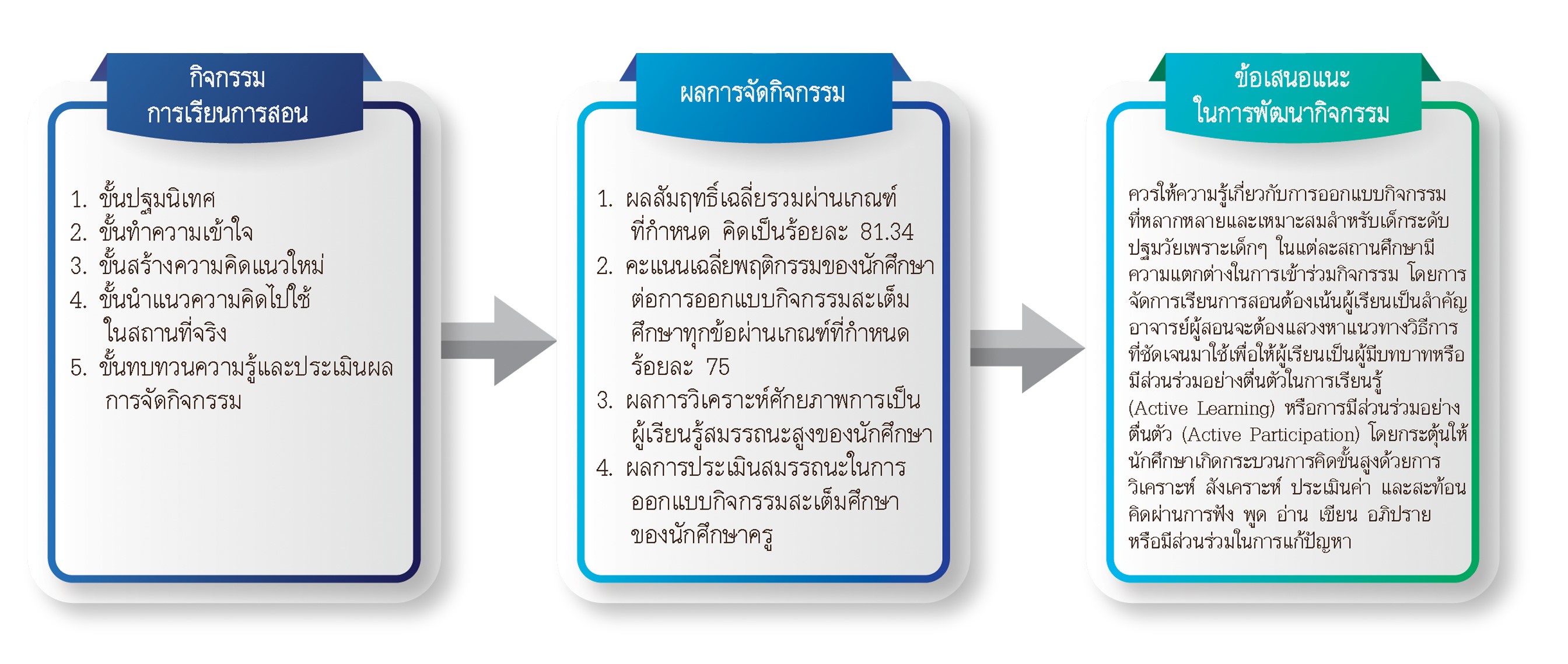The Development of Teaching and Learning Activities that Enhance the Potential of High-Performance Learners in the Design of STEM Education Activities for Early Children of Teacher Students Surindra Rajabhat University
Main Article Content
Abstract
The purposes of this research were 1) Develop teaching activities that promote high-performance learning potential in designing STEM activities for early childhood students, 2) to study the results of the activities and 3) guidelines and suggestions from the developed activities. The sample group were 58 education students by purposive selection. The tools used to collect data are tests, questionnaires, observation forms, and interviews. Data were analyzed by looking for percentages, means, and standard deviations and content analysis.
The finding researches were as follows:
1. Results of operations to develop teaching and learning activities have 5 steps: 1) Orientation step. 2) Understanding 3) Create a new idea 4) Step to apply the concept in real place and 5) the stage of reviewing knowledge and evaluating the results of organizing activities.
2. The average overall achievement score was 10.67 with the highest average overall score of 1.72 percent. The students' overall potential of students to be high-performing learners is at a high level. The students' overall performance in designing STEM education activities was at a high average level.
3. Guidelines and suggestions for developing teaching and learning activities are: Knowledge should be given about designing diverse and appropriate activities for early childhood children because children in educational institutions have differences in how they participate in activities. In teaching and learning, the focus must be on the learners. Instructors must seek guidelines. The clear methods are used to enable learners to be active players or participants in active learning or active participation.
Article Details

This work is licensed under a Creative Commons Attribution-NonCommercial-NoDerivatives 4.0 International License.
เพื่อให้เป็นไปตามกฎหมายลิขสิทธิ์ ผู้นิพนธ์ทุกท่านต้องลงลายมือชื่อในแบบฟอร์มใบมอบลิขสิทธิ์บทความ ให้แก่วารสารฯ พร้อมกับบทความต้นฉบับที่ได้แก้ไขครั้งสุดท้าย นอกจากนี้ ผู้นิพนธ์ทุกท่านต้องยืนยันว่าบทความ ต้นฉบับที่ส่งมาตีพิมพ์นั้น ได้ส่งมาตีพิมพ์เฉพาะในวารสาร วิชาการธรรม ทรรศน์ เพียงแห่งเดียวเท่านั้น หากมีการใช้ ภาพหรือตารางของผู้นิพนธ์อื่นที่ปรากฏในสิ่งตีพิมพ์อื่นมาแล้ว ผู้นิพนธ์ต้องขออนุญาตเจ้าของลิขสิทธิ์ก่อน พร้อมทั้ง แสดงหนังสือที่ได้รับการยินยอมต่อบรรณาธิการ ก่อนที่บทความจะได้รับการตีพิมพ์References
นาฏฤดี จิตรรังสรรค์. (2563). ถอดบทเรียนการจัดการเรียนรู้อิงสมรรถนะระดับประถมศึกษาตอนปลายกับตัวอย่างหน่วยการเรียนรู้ “แพช่วยชีวิต”. วารสารวิชาการสำนักงานคณะกรรมการการศึกษาขั้นพื้นฐาน, 23(3), 13-21.
บุญเลี้ยง ทุมทอง และเฉลิมชัย โสสุทธิ์. (2555). การศึกษาศักยภาพการเป็นผู้เรียนรู้ตลอดชีวิตของนักศึกษามหาวิทยาลัยราชภัฏบุรีรัมย์. บุรีรัมย์: มหาวิทยาลัยราชภัฏบุรีรัมย์.
ปัญจนาฏ วรวัฒนชัย. (2565). ความรู้พื้นฐานเกี่ยวกับความคิดสร้างสรรค์. วารสารครุศาสตร์สาร มหาวิทยาลัยราชภัฏบ้านสมเด็จเจ้าพระยา, 16(1), 14-31.
พัดชา ดอกไม้, ศศิธร โสภารัตน์ และอภิชาติ พยัคฆิน. (2566). การพัฒนากระบวนการจัดการเรียนรู้ตามแนวคิดสะเต็มศึกษาเพื่อส่งเสริมความสามารถในการผลิตและใช้ชุดกิจกรรมการเรียนรู้สะเต็มของนักศึกษาครูวิทยาศาสตร์. วารสารศึกษาศาสตร์ มหาวิทยาลัยนเรศวร, 25(1), 181-194.
สวนันท์ แดงประเสริฐ และภาวพรรณ ขำทับ. (2562) การพัฒนาโครงสร้างหลักสูตรฐานสมรรถนะตามมาตรฐานอาชีพ. วารสารพัฒนาเทคนิคการศึกษา, 32(112), 27-36.
สำนักงานคณะกรรมการการศึกษาขั้นพื้นฐาน. (2563). นโยบายสำนักงานคณะกรรมการการศึกษาขั้นพื้นฐาน ปีงบประมาณ 2563. กรุงเทพฯ: สำนักงานคณะกรรมการการศึกษาขั้นพื้นฐาน.
สำนักงานเลขาธิการสภาการศึกษา. (2562). มาตรฐานการศึกษาของชาติ พ.ศ. 2561. กรุงเทพฯ: สำนักงานเลขาธิการสภาการศึกษา.
_______. (2563). สรุปผลการประชุมโต๊ะกลมไทย-สหรัฐฯ ด้านการศึกษา ครั้งที่ 7: สะเต็มศึกษา: วัฒนธรรมการเรียนรุ้สำหรับกำลังคนในศตวรรษที่ 21. กรุงเทพฯ: พริกหวานกราฟฟิค.
_______. (2566). การวิจัยเชิงปฏิบัติการเพื่อพัฒนาระบบและกลไกการพัฒนาและส่งเสริมพหุปัญญาของผู้เรียน. กรุงเทพฯ: สำนักมาตรฐานการศึกษาและพัฒนาการเรียนรู้.
Joyce, B. & Weil, M. (2000). Model of teaching. (6th ed.). Boston: Alyn and Bacon.
Ladachart, L., et al. (2019). Teachers’ understanding and views about STEM education and engineering design. Silpakorn University Journal, 39(3), 133-149.
Pimthong, P. (2018). STEM education. Bangkok: Vista Interprint.

